We use cookies on this website. Cookies help us deliver the best experience on our website. Read about cookies.
-
- Education
- Education
- Programmes and courses
- Applications and admissions
- Tuition fees
- Scholarships
- Exchange studies at Malmö University
- Study Guidance
-
- After admission
- After admission
- Moving to Malmö
- Pre-orientation
- Arrival guide
-
- About studies at Malmö University
- About studies at Malmö University
- Why choose Malmö University
- Understanding university studies
- Connect with our students
On the page -
- Research
- Research
-
- Doctoral studies
- Doctoral studies
- Doctoral courses
-
- Doctoral schools
- Doctoral schools
- Adaptation of urban space through sustainable regeneration
- ComBine
- Culturally Empowering Education through Language and Literature
- Education, Learning and Globalisation
- Finding ways in a time of great future challenges (FinnFram)
- Swedish National Graduate School in Science and Technology Education Research
- Learning in Multicultural Societal Contexts
- Pedagogy and Vocational Skills
- Relevancing Mathematics and Science Education (RelMaS)
- Sustainable Movement Education
- The National Research School for Professionals in Social Services
- Research subjects
-
- Research centres
- Research centres
- Biofilms Research Centre for Biointerfaces
- Citizen Health
- Imagining and Co-Creating Futures
- Institute for Urban Research
- Malmö Institute for Migration Studies
- Literacy and Inclusive Teaching
- Centre for Work Life Studies
- Sustainable Digitalisation Research Centre
- Centre for Sexology and Sexuality Studies
-
- Research publications
- Research publications
- Search for research publications in Diva
- Malmö University Press
- Research events
- Participate in a research study
- Coffee Break Quiz
On the page -
- Collaboration and Innovation
- Collaboration and Innovation
- Innovation
- Collaboration with students
-
- Collaborate with researchers
- Collaborate with researchers
- Labs and facilities
- Culture collaboration
- Support Malmö University
- Alumni & Friends
On the page -
- About us
- About us
-
- Faculties and departments
- Faculties and departments
-
- Faculty of Culture and Society
- Faculty of Culture and Society
- Department of Global Political Studies
- School of Arts and Communication
- Department of Urban Studies
-
- Faculty of Education and Society
- Faculty of Education and Society
- Department of Childhood, Education and Society
- Department of Sports Sciences
- Department of Culture, Languages and Media
- Department of Natural Science, Mathematics and Society
- Department of Society, Culture and Identity
- Department of School Development and Leadership
-
- Faculty of Technology and Society
- Faculty of Technology and Society
- Department of Computer Science and Media Technology
- Department of Materials Science and Applied Mathematics
- Faculty of Odontology
- University Dental Clinic
-
- Find and contact Malmö University
- Find and contact Malmö University
- Visit Malmö University
-
- News and press
- News and press
- Graphic manual
- Map of the buildings (Google Maps)
- Merchandise
- Supplier information and invoice management
- Whistleblowing
- Management and decision-making paths
-
- Malmö University's strategy 2030
- Malmö University's strategy 2030
- Sustainability
- Widened recruitment and participation
- Quality assurance work at the University
-
- Malmö Academic Choir and Orchestra
- Malmö Academic Choir and Orchestra
- Student work – video pieces
-
- Annual Academic Celebration
- Annual Academic Celebration
- Academic traditions
- Meet our new professors
- Meet our new doctors
- Honorary doctors
- The University in a troubled world
On the page
Academic traditions
traditions
About Malmö University's academic traditions and the insignia used at the ceremonies.
Medieval traditions remastered
Malmö University’s conferment and professorial inauguration ceremony celebrates and honours the academic achievements of the past year. Of all the medieval traditions that surround these academic ceremonies, some have been passed on over centuries and now live on in our young University in the heart of Malmö.
Insignia video
The video about the academic traditions and insignia is in Swedish, with optional subtitles in Swedish or English.
Doctor, professor
Doctoral degree conferment
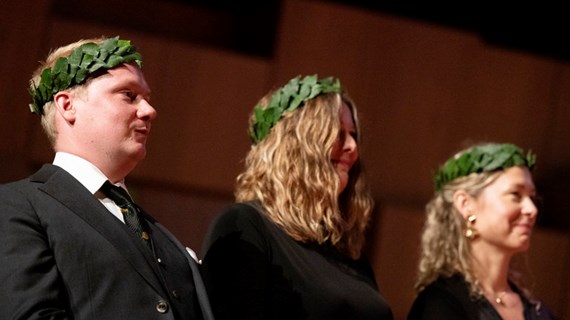
Doctoral degree conferment
The doctoral degree conferment is a ceremony for those who have completed their doctoral studies and defended their thesis in the past academic year. The Swedish word ‘promovera’ comes from the Latin ‘promovere’, and means ‘moving forward’. The conferment ceremony symbolises a scientific journey, inspired by Greek mythology where knowledge is transported over Mount Parnassus. During the ceremony, this journey is symbolised by the doctor passing a podium, called the parnassus, which grants the symbolic right to teach.
Professorial inauguration
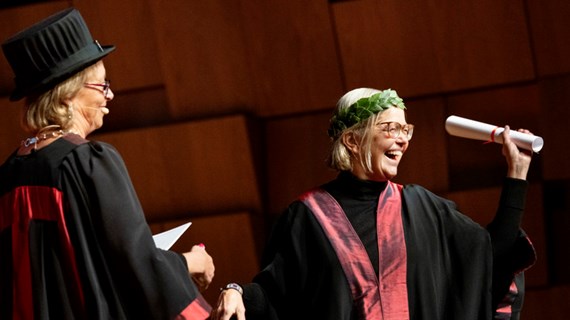
Professorial inauguration
In Sweden, a professor is the highest teaching position at universities and colleges. At the professorial installation, those appointed as professors are installed and welcomed into the collegium by university representatives. This act is preceded by an inauguration lecture given by all future professors earlier in the week. The Vice-Chancellor installs the new professor.
honorary doctor, jubilee doctor
Honorary doctor

Honorary doctor
Honorary doctorates are often awarded to academics at other universities, but just as often honorary doctorates are awarded to people based outside academia. They are people that the University wants to reward and recognise for their commitment and deeds in promoting scientific research. Honorary doctorates are appointed by the faculties.
Jubilee doctor
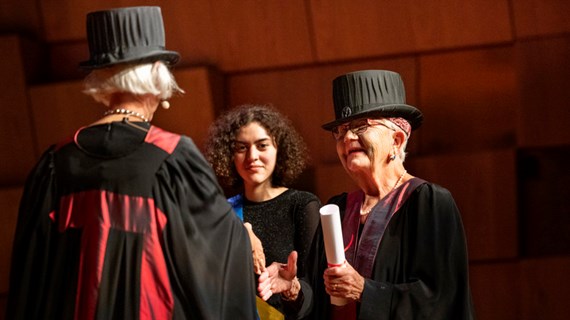
Jubilee doctor
Some years, the University has the privilege of awarding a jubilee doctorate. This title is bestowed on a person who has received a doctorate from a university 50 years earlier. During the ceremony, the jubilee doctor is awarded a diploma. In 2019, the University's first Vice-Chancellor Per-Olof Glantz became a jubilee doctor.
What are insignia?
Insignia are the symbolic objects and tokens of honour awarded at the doctoral degree conferment ceremony. The hat and the wreath symbolise freedom but also power, and with power comes responsibility. The ring symbolises fidelity and dedication to the ideals of science.
During the conferment ceremony, the new doctors are also presented with a diploma, which used to be the written proof of their degree and had to be carried with them when travelling to other universities, for example. Today, the diploma lives on as a nice memento of the ceremony.
Doctoral hat, laurel wreath and Doctoral ring
Doctoral hat and laurel wreath
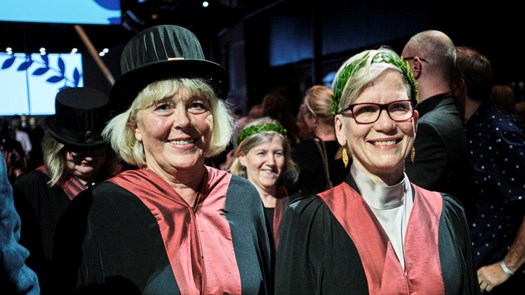
Doctoral hat and laurel wreath
The doctoral hat and laurel wreath symbolise freedom but also power. The doctoral hat is worn by those with doctoral degrees in technology, medicine and odontology. Those with a doctoral degree in philosophy wear a laurel wreath.
Doctoral ring
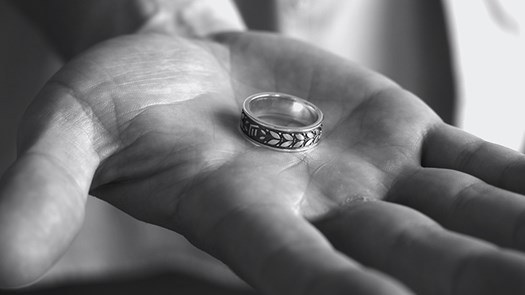
Doctoral ring
The ring symbolises commitment and dedication to scientific ideals. Malmö University offers three doctoral rings; a university-wide doctoral ring in Humanium Metal (produced by Individual Human Help), a university-wide doctoral ring in gold, and a faculty-specific doctoral ring in gold for the Faculty of Odontology.
Robe
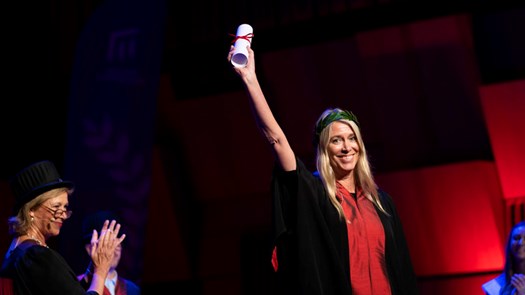
Robe
The ‘robe’ is the formal academic gown worn by the vice chancellor, conferrers, deans, and professors during the conferment ceremony and at other academic events. Malmö University has chosen to use the talar as a symbol of equality and unity.
Peace metal
Malmö University is the first university in the world to use 'peace metal' for its doctoral rings, the Vice-Chancellor's chain, and the deans' chains. Humanium Metal is produced by the non-profit organisation Individual Human Help (IM) and is made of recycled metal from collected and stored weapons from Guatemala and El Salvador.
Peace metal
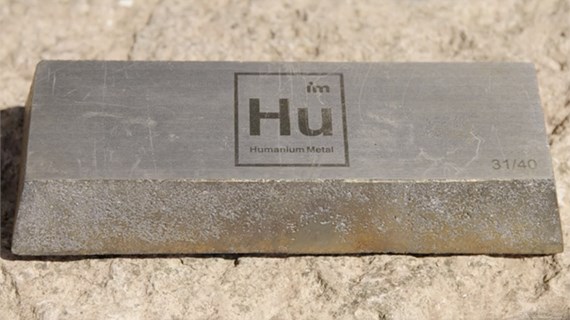
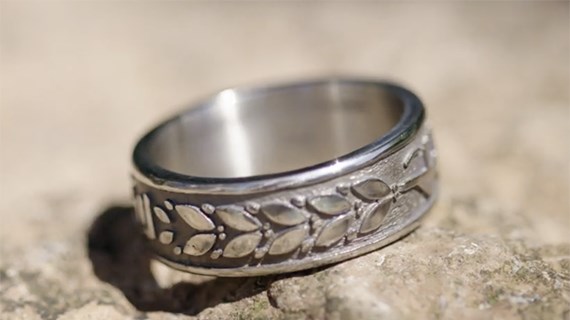
Chain
Vice-Chancellor’s chain
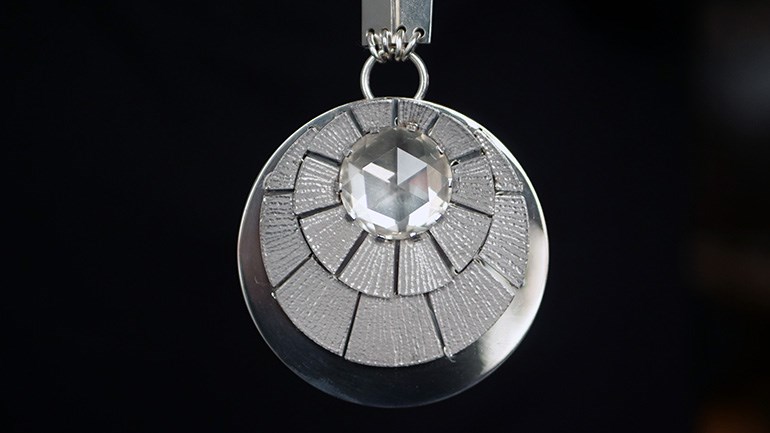
Vice-Chancellor’s chain
The Vice-Chancellor’s chain is a symbol of office and is worn at formal academic events. Malmö University's values of an open society, freedom of speech, and critical thinking have been incorporated into its design by Ingegerd Råman. In addition to Humanium Metal, the medallion is made of silver and glass crystal. The two cogwheels symbolise people's ability to constantly evolve and think in new ways. The prismatic crystals create multiple reflections which represents contrasting perspectives and opinions.